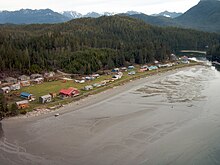
Opitsaht, spelled also as Opitsat and Opitsitah, is a First Nations settlement/community in the Southwest area of the Meares Islands, Clayoquot South, British Columbia. This peninsula-like region is the home to Tla-o-qui-aht First Nations of the Nuu-chah-nulth nation. The Tla-o-qui-aht are an Indigenous group from the Pacific Northwest region in the lower Vancouver area, known for their lifestyle revolving around the marine life trade and culture within the community.
During the era of the Maritime Fur Trade, Opitsaht was the seat of Wickaninnish, chief of the Tla-o-qui-aht. In 1791 the Spanish explorer Francisco de Eliza estimated a population of about 2,500 people. According to John Boit in 1792 the village contained 200 ornately carved buildings typical of Nuu-chah-nulth villages.[1] John Kendrick made a strong alliance with Wickaninnish in the summer of 1791.[2] Although Wickaninnish remained an ally of Kendrick, the good feelings towards Americans that Kendrick had built were ruined by Kendrick's former partner Robert Gray. The original village of Opitsaht was lost when Gray ordered it destroyed by the cannons of the Columbia Rediviva as part of a falling-out with the Tla-o-qui-aht when Gray evacuated his erstwhile "fort" nearby on Meares Island, known as Fort Defiance.[2] Today, Opitsaht is one of the main villages of Tla-o-qui-aht First Nations.
The population of Opitsat Indian Reserve No. 1, which is named after the village and is an official land status used by Statistics Canada as a census area, was 174 at the Census of 2006.[3]
- ^ Clayton, Daniel (2011). Islands of Truth: The Imperial Fashioning of Vancouver Island. University of British Columbia Press. p. 132. ISBN 978-0-7748-4157-3. Retrieved 25 November 2020.
- ^ a b Ridley, Scott (2010). Morning of Fire: John Kendrick's Daring American Odyssey in the Pacific. Harper Collins. pp. 231–246. ISBN 978-0-06-202019-2. Retrieved 25 November 2020.
- ^ "Community Profiles from the 2006 Census, Statistics Canada - Census Subdivision". Statistics Canada. Archived from the original on 2016-12-01.